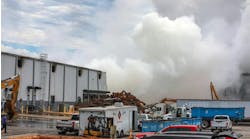Podcast: Could Deepwater Horizon Have Been Prevented?
Transcript
Traci: Welcome to this edition of "Process Safety" with Trish and Traci, the podcast that aims to share insights from past incidents to help avoid future events. I'm Traci Purdum, executive digital editor with Chemical Processing. And as always, I'm joined by Trish Kerin, the director of the IChemE Safety Centre. Hello, Trish, what's going on with you?
Trish: Hey, Traci. How are you doing today?
Traci: I'm doing all right. Trying to stay dry. We're having lots of storms in the Cleveland, Ohio area but we're doing all right.
Trish: All right. Good. We're starting to get a little bit more daylight each day as we start to come out of winter. So, it's a beautiful morning at the moment. The sun's risen, blue sky, but it's a bit cold outside.
Traci: Well, we have exactly the opposite. So, we'll always be that way, Trish. We'll be the exact opposites in weather.
Trish: We will.
Traci: Well, as we often do, we're looking back at a past incident to see what we can learn today. In this case, it's the anniversary of the oil and gas leak in the Montara oil field, which took place off the Northern Coast of Western Australia between August 21st and November 3rd, 2009. While there is a lot to learn from just this incident on its own, what stands out is that it happened just months prior to the Deepwater Horizon disaster. Can you catch us up to speed on some of the Montara incident? What happened there?
Trish: Sure. I'll try. Basically, what we saw at Montara was a well blowout had occurred and that then caused the leaking of oil and gas before it was eventually kept, I think, for about 75 days. There was five attempts to cap the well. In fact, if they weren't able to cap it on the first floor, it took the fifth attempt that drove relief well and kept it that way. All 69 workers in this incident were actually evacuated to safety, which was a fantastic result from the human perspective. But obviously, there was a significant environmental impact that occurred for oil and gas leaking for that length of time. And it was interesting that what we saw in this incident was the cement shoe, cement casing shoe failed. The well kicked and it pushed past the failed cement shoe and resulted in the oil and gas reaching the surface and then flowing unabated for some period of time.
It was interesting when they actually built and while they were working on the well and installing it, they didn't necessarily follow the appropriate standards, both industry international and even company standards in building it. And so, they hadn't properly pressure tested the cement casing shoe when it had been installed. And there had been a lot of trouble with that cement job as well. It hadn't gone smoothly. There had been issues with it along the way but they didn't properly pressure test it. So they didn't know whether it was holding. And then they were meant to actually install two pressure-containing anti-corrosion cap head caps to basically protect it in situ at the time.
Also went away and did some other things but they only installed one and didn't test that when they installed that either. So, that didn't work effectively. Now, it's also important to note that the manufacturers of pressure-containing anti-corrosion caps very clearly specify they're not actually intended to be a barrier either. They're intended to basically stop corrosion. They're not a barrier to a well, but they had kind of been relied on as being a barrier in this process.
And there was meant to be two of them as a barrier, except there wasn't two of them. There's only one and it wasn't tested properly. We can start to see we're seeing a lot of failures that occurred in the lead up to this. When they later removed that pressure containing anti-corrosion cap, they then started to do other work on the well. That was when it suffered the initial blowout. And the incident basically then took place from there. So, there was a whole series of issues around what happened with that. You know, there wasn't effectively a blowout preventer on that well, and hence we saw a substantial oil leak occur at that time, I believe it might have been the worst in the history of Australian operations.
Traci: How did this parallel what happened with Deepwater Horizon? It was pretty close, wasn't it?
Trish: It was. And that was I think one of the really concerning things about it, but this happened months before Deepwater Horizon happened. I think. Now, in Deepwater Horizon, you remember that there was an issue with the cement shoe casing. It was not a good cement pour, even though they thought it was a good cement pour. When they were testing it and they were getting results that suggested there was something wrong with it, those results were put down to something else occurring because they believed that it was a good cement pour. And that's a phenomenon of confirmation bias when we only really see the information that confirms our theory.



